功能语法
- 格式:doc
- 大小:40.50 KB
- 文档页数:6


语法功能名词解释语法功能名词解释如下:1. 主语 (Subject):句子中的主语是指句子所描述的人或物,通常是句子的核心。
主语通常是动词所描述的动作或状态的执行者。
例如:“The cat is sleeping on the bed.”中的“the cat”就是主语。
2. 谓语 (Predicate):谓语是用来说明主语的动作、状态或情况的动词或形容词。
谓语通常用来表示句子的主语所做的动作或所处的状态。
例如:“The cat is sleeping on the bed.”中的“is sleeping”就是谓语。
3. 宾语 (Object):宾语是指句子中执行动作的人或物,通常是句子中动词所描述的动作的对象。
例如:“I give the cat to my friend.”中的“the cat”就是宾语。
4. 定语 (Adverbial):定语是用来修饰名词或代词的词语,可以是形容词、副词或介词短语等。
例如:“The beautiful sunset in the background.”中的“beautiful”就是定语。
5. 状语 (Adverb):状语是用来修饰动词、形容词、副词或整个句子的词语,可以表示时间、地点、方式、原因等。
例如:“I am running to the store to buy some food.”中的“to the store”就是状语。
6. 补语 (Concessive):补语是用来补充说明主语或宾语的状态、动作或情况的词语,通常用来描述主语或宾语的动词或形容词。
例如:“The cat is sleeping on the bed.”中的“is sleeping”就是补语。
7. 并列句 (Conjunction):并列句是用来连接两个或多个句子的词语,可以表示并列、递进、转折等关系。
例如:“I like to eat pizza, but I also loveto eat chicken wings.”中的“but”就是并列句。
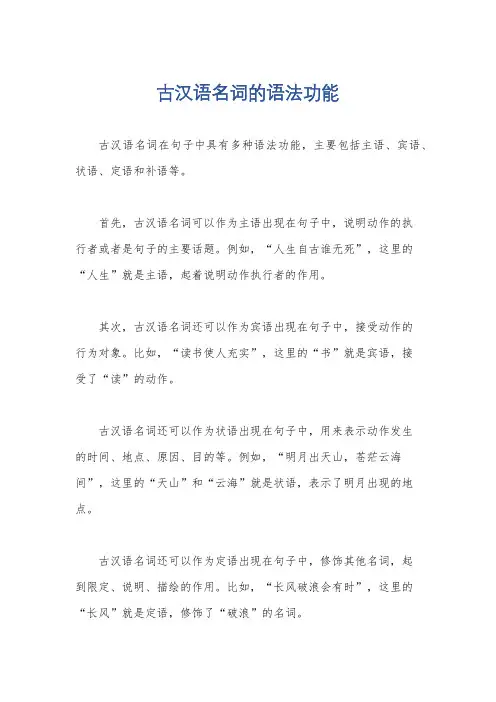
古汉语名词的语法功能
古汉语名词在句子中具有多种语法功能,主要包括主语、宾语、状语、定语和补语等。
首先,古汉语名词可以作为主语出现在句子中,说明动作的执
行者或者是句子的主要话题。
例如,“人生自古谁无死”,这里的“人生”就是主语,起着说明动作执行者的作用。
其次,古汉语名词还可以作为宾语出现在句子中,接受动作的
行为对象。
比如,“读书使人充实”,这里的“书”就是宾语,接
受了“读”的动作。
古汉语名词还可以作为状语出现在句子中,用来表示动作发生
的时间、地点、原因、目的等。
例如,“明月出天山,苍茫云海间”,这里的“天山”和“云海”就是状语,表示了明月出现的地点。
古汉语名词还可以作为定语出现在句子中,修饰其他名词,起
到限定、说明、描绘的作用。
比如,“长风破浪会有时”,这里的“长风”就是定语,修饰了“破浪”的名词。
最后,古汉语名词还可以作为补语出现在句子中,用来补充说明动词或形容词的意义。
例如,“心如古井”,这里的“古井”就是补语,补充了“心”这个名词的意义。
总的来说,古汉语名词在句子中具有丰富的语法功能,可以充当主语、宾语、状语、定语和补语,起着不可或缺的作用。
通过对古汉语名词的灵活运用,可以丰富句子的表达方式,使语言更加生动、形象。
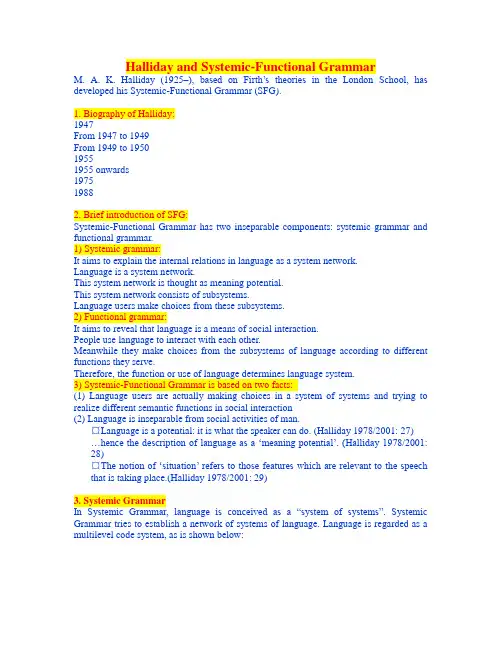
Halliday and Systemic-Functional GrammarM. A. K. Halliday (1925–), based on Firth‘s theories in the London School, has developed his Systemic-Functional Grammar (SFG).1. Biography of Halliday:1947From 1947 to 1949From 1949 to 195019551955 onwards197519882. Brief introduction of SFG:Systemic-Functional Grammar has two inseparable components: systemic grammar and functional grammar.1) Systemic grammar:It aims to explain the internal relations in language as a system network.Language is a system network.This system network is thought as meaning potential.This system network consists of subsystems.Language users make choices from these subsystems.2) Functional grammar:It aims to reveal that language is a means of social interaction.People use language to interact with each other.Meanwhile they make choices from the subsystems of language according to different functions they serve.Therefore, the function or use of language determines language system.3) Systemic-Functional Grammar is based on two facts:(1) Language users are actually making choices in a system of systems and trying to realize different semantic functions in social interaction(2) Language is inseparable from social activities of man.¤Language is a potential: it is what the speaker can do. (Halliday 1978/2001: 27) …hence the description of language as a ‗meaning potential‘. (Halliday 1978/2001:28)¤The notion of ‗situation‘ refers to those features which are relevant to the speech that is taking place.(Halliday 1978/2001: 29)3. Systemic GrammarIn Systemic Grammar, language is conceived as a ―system of systems‖. Systemic Grammar tries to establish a network of systems of language. Language is regarded as a multilevel code system, as is shown below:This is what Halliday called the three strata of language.¤Language is being regarded as the encoding of a ‗behaviour potential‘; that is, as a means of expressing what the human organism ‗can do‘, in interaction with other human organisms, by turning it into what he ‗can mean‘. What he can mean (the semantic system) is, in turn, encoded into what he ‗can say‘ (the lexicogrammatical system, or grammar and vocabulary); to use our own folk-linguistic terminology, meanings are expressed in wordings. Wordings are, finally, recorded into sounds (it would be nice if we could say ‗soundings‘) or spellings (the phonological and orthographic systems). (Halliday 1978/2001: 21)A system is a list of choices or options. Systems and subsystemsTransitivity, mood and thematic systems are respectively components of the ideational, interpersonal and textual functions.Mood (see textbook P. ____)As is shown above, we divide a general area of meaning into smaller and smaller sub-areas. We make finer and finer distinctions in meaning. That is to say, we arrange systems and sub-systems on a scale according to the fineness of meaning. This scale is called SCALE OF DELICACY.4. Functional GrammarHalliday‘s Systemic Grammar contains a functional component (Halliday, 1985/1994/2004). He interprets language development from a functional point of view and formulates a functional theory of language.Because of the complexity of adult language, Halliday reduced the seven functions to a set of highly coded and abstract functions, which are meta-functions: the ideational, the interpersonal, and the textual functions.1) The ideational function refers to the fact that we use language to talk about our experience of the world, including the worlds in our own minds, to describe events and states and the entities involved in them.2) The interpersonal function means that we also use language to interact with other people, to establish and maintain relations with them, to influence their behavior, to express our own viewpoint on things in the world, and to elicit or change theirs.3) The textual function means that in using language, we organize our messages in ways which indicate how they fit in with the other messages around them and with the widerTransitivity is simply the grammar of the clause in its ideational aspect. We have six processes in transitivity system: Material processes, Mental processes, Relational processes, V erbal processes, Behavioral processes, Existential processes.1) Material processes are those in which something is done.3)Relational processes can be classified into two types: Attributive and Identifying. These two relations can be further classified into Intensive, Circumstantial, and Possessive.There is a new office building at the end of the road.Does life exist on Mars?uses of language to express social and personal relations. Interpersonal function is realised by mood and modality. Mood shows what role the speaker selects in the speech situation and what role he assigns to the addressee. If the speaker selects the imperative mood, he assumes the role of one giving commands and puts the addressee in the role of one expected to obey orders.1) Mood is made up of two parts: the ―Subject‖ and the ―Finite‖ element. The subject can be a noun, a noun phrase, or a clause. Finite elements are tense morphemes, auxiliary verbs and modal verbs that express tense or modality . Residue refers to the rest of theComplement Subject Finite element Predicator AdverbialResidue Mood Residue2) Modality specifies if the speaker is expressing his judgment of proposition, possibility According to Halliday, of the various speech roles, two are the most basic: giving and taking. In interpersonal communications, the commodities exchanged can also fall intotwo kinds: goods-&-services and information. Thus, speech roles and commodities exchanged make up four principal speech roles:offer, command, statement, and question.Commodity exchangedRole in exchange Proposal/goods-&-services Proposition/informationgivingofferWould you like this teapot?statementHe’s giving her the teapot demandingcommandGive me that teapot!questionWhat is he giving her?of order, command, statement and question. They, in turn, are matched by a set of desired responses: accepting an offer, carrying out a command, acknowledging a statement and―Speech Functions and Responses‖:Initiation expected response discretionary alternative Give goods-&-servicedemand goods-&-servicesgive informationdemands informationOffercommandstatementquestionacceptanceundertakingacknowledgementanswerrejectionrefusalcontradictiondisclaimer7. The Textual FunctionThe textual function refers to the fact that language has mechanisms to make any stretchof spoken or written discourse into coherence. It provides the remaining strands of meaning potential to be woven into the fabric of linguistic structure. It is realized by cohesive devices such as reference, ellipsis, substitution, conjunction.1) Reference:exophoric reference:Who is he?(he is not mentioned in the text.)endophoric reference:J ane is a friend of mine. She works in Hong Kong. (she=Jane)Mary dances better than June does 中,用does 代替dances〕endophoric reference includes: anaphoric reference and cataphoric referenceanaphoric reference:J ane is a friend of mine. She works in Hong Kong.(Jane←She回指)cataphoric reference:Here is the news: Linda and Williams are getting married next week.(Here the news下指)2) Ellipsis: A: How given/known are you, boy? B: Seven, sir.3) Substitution: A: Has John passed the exam? B: I think so.4) Conjunction:and, but, because; nevertheless, therefore, however; because of, by the way, as I was saying; …(Communicative Sentence Pattern)。
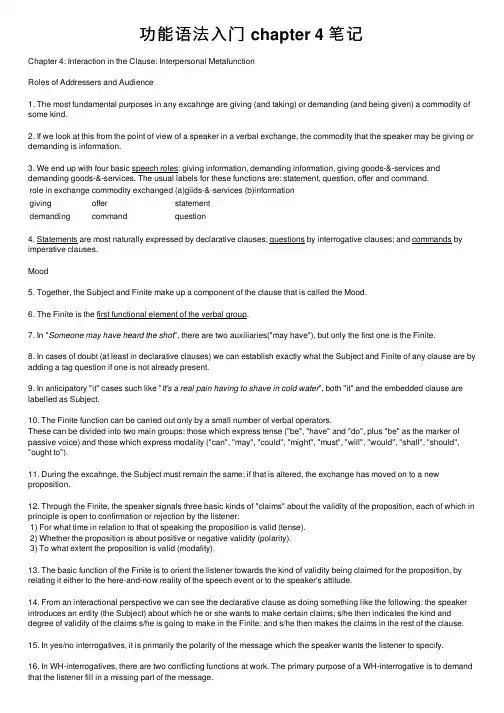
功能语法⼊门 chapter 4 笔记Chapter 4: Interaction in the Clause: Interpersonal MetafunctionRoles of Addressers and Audience1. The most fundamental purposes in any excahnge are giving (and taking) or demanding (and being given) a commodity of some kind.2. If we look at this from the point of view of a speaker in a verbal exchange, the commodity that the speaker may be giving or demanding is information.3. We end up with four basic speech roles: giving information, demanding information, giving goods-&-services and demanding goods-&-services. The usual labels for these functions are: statement, question, offer and command.role in exchange commodity exchanged(a)giids-&-services(b)informationgiving offer statementdemanding command question4. Statements are most naturally expressed by declarative clauses; questions by interrogative clauses; and commands by imperative clauses.Mood5. Together, the Subject and Finite make up a component of the clause that is called the Mood.6. The Finite is the first functional element of the verbal group.7. In "Someone may have heard the shot", there are two auxiliaries("may have"), but only the first one is the Finite.8. In cases of doubt (at least in declarative clauses) we can establish exactly what the Subject and Finite of any clause are by adding a tag question if one is not already present.9. In anticipatory "it" cases such like "It's a real pain having to shave in cold water", both "it" and the embedded clause are labelled as Subject.10. The Finite function can be carried out only by a small number of verbal operators.These can be divided into two main groups: those which express tense ("be", "have" and "do", plus "be" as the marker of passive voice) and those which express modality ("can", "may", "could", "might", "must", "will", "would", "shall", "should", "ought to").11. During the excahnge, the Subject must remain the same: if that is altered, the exchange has moved on to a new proposition.12. Through the Finite, the speaker signals three basic kinds of "claims" about the validity of the proposition, each of which in principle is open to confirmation or rejection by the listener:1) For what time in relation to that of speaking the proposition is valid (tense).2) Whether the proposition is about positive or negative validity (polarity).3) To what extent the proposition is valid (modality).13. The basic function of the Finite is to orient the listener towards the kind of validity being claimed for the proposition, by relating it either to the here-and-now reality of the speech event or to the speaker's attitude.14. From an interactional perspective we can see the declarative clause as doing something like the following: the speaker introduces an entity (the Subject) about which he or she wants to make certain claims; s/he then indicates the kind and degree of validity of the claims s/he is going to make in the Finite; and s/he then makes the claims in the rest of the clause.15. In yes/no interrogatives, it is primarily the polarity of the message which the speaker wants the listener to specify.16. In WH-interrogatives, there are two conflicting functions at work. The primary purpose of a WH-interrogative is to demand that the listener fill in a missing part of the message.17. Exclamatives are like WH-interrogatives in that they have a WH-element, which typically comes first; but they have the Subject^Finite ordering of declarative clauses.18. In imperatives, most of the functions of the Finite are irrelevant: a command is absolute, and there is no need to specify time relevance since there is no choice. And the Finite may in fact appear in unmarked imperatives, but it has a restricted purpose: it is used only to signal negative polarity.19. There is in fact a second kind of imperative clause, where the understood Subject is not "you" but "you and me": this is the "let's" form. The tag in these cases is "shall we?"20. The general term for part of the clause that is not the Mood is the Residue. There are three kinds of functional elements in the Residue: the Predicator, Complements, and Adjuncts.21. The Predicator is expressed by the rest of the verbal group apart from the Finite. There can be only one Predicator in any clause, and there must be a Predicator in any major clause. Since the Finite is not part of the Predicator, the Predicator itself is non-finite.22. The Predicator obviously expresses the process - the action, happening, state, etc. in which the Subject is involved. In addition, it may perform three other functions:1) To specify "secondary tense", that is, time reference other than the immediatelink to the time of speaking.2) To specify various other aspects of the process, such as starting, trying,achieving or continuing the process.3) To specify the voice: active or passive.23. The term Complements includes both Objects and Complements in the more traditional sense. A Complement is an element in the Residue, typically realised by a nominal group, which could have been chosen as Subject, but was not.24. There is one kind of Complement which cannot become Subject. That is the Attribute in a relational process.25. Adjuncts cannot in themselves be chosen as Subject - that is the main difference between Adjuncts and Complements.26. There are three types of Adjunct. The Adjunct that tell us things like when, or how, or where, or why the event happened are called "circumstantial Adjunct". The other two types are Conjunctive Adjunct and Modal Adjunct.27. Conjunctive Adjunct are sometimes called "discourse markers". They have the function of signalling how the clause as a whole fits in the preceding text. They are not regarded as playing any part in the interpersonal meanings of the clause, and thus they do not form part of either the Mood or the Residue.28. Modal Adjunct clearly do have an interpersonal function. These Adjuncts fall into two main groups:1) Comment Adjuncts typically comment on the clause as a whole rather than give circumstantial information about the event, and they are often separated off from the rest of the clause by commas.2) Mood Adjuncts are in fact most colsely related not to the Predicator in the verbal group but to the Finite: they express meanings associated with tense, polarity and modality.Both types of Modal Adjunct - Mood and Comment - are included in Mood when you do a Mood-Residue analysis.cf. See the Comment Adjuncts and Mood Adjuncts shown at the end below.Modality29. The Finite expresses not only tense but also polarity and modality. Any Finite is inherently positve or negative in polarity.30. Polarity may also be expressed through Mood Adjuncts such as "never" or "hardly".31. The expression of polarity can even be expressed by the Complement, such as "nothing".32. If the commodity being exchanged is information, the modality relates to how valid the information is in terms of probability (how likely it is to be ture) or usuality (how frequently it is true). Some of the basic points on the probability scale are: possible/probable/certain; on the usuality scale, they include: sometimes/often/always.33. If the commodity is goods-&-services, the modality relates to how confident the speaker can be in the eventual success ofthe exchange. In commands, this concerns the degree of obligation on the other person to carry out the command (the scale for the demanded goods-&-services includes: permissible/advisable/obligatory), while in offers it concerns the degree of willingness or inclination of the speaker to fulfil the offer (the speaker may signal: ability/willingness/determination).34. Of the two types of modality mentioned above, the first is called modalisation, whereas the second is referred to as modulation.35. There are a number of ways in which it can be expressed.1) The most obvious, and one of the main structual justifications for including modality as a function of the Mood in English, is through modal verbal operators.2) Apart from a modal verbal operator, modality may also be signalled in Mood by a Mood Adjunct.36. Modal commitment is the degree to which the speaker commits himself or herself to the validity of what s/he is saying.37. The speaker may express his or her point of view in a way that "objectivises" the point by making it appear to be a quality of the event itself.38. At the other extreme, the subjective nature of the assessment allow the speaker to express his or her point of view in a way that makes it clear that this is his or her subjective point of view.39. The two main ways of expressing modalilty has been mentioned above: modal verbal operators and Mood Adjuncts. Of these, modal operators exploit the Finite slot and thus are firmly rooted in the interpersonal, subjective meanings of the clause; whereas Mood Adjuncts are a step closer to the objective end of the spectrum, in that they use one ofthe Adjunct slots which are typically used to express "real-world" features of the event.40. The term "implicit" is used when the modality is expressed in the same clause as the main proposition, while "explicit" is used when it is expressed in a separate clause. See below:Modalisation ModulationExplicit subjective I'm sure we should sell this place.I don't advise you to drink it.Implicit subjective She might have written to me.I mustn't go there any more.Implicit objective We probably won't repay it. A cathedral is supposed to be old.Explicit objective It's likely that they've heard by now.It's essential that you leave at once.41. Prepositional phrases expressing modality lie somewhere between the explicit and implicit points exemplified above.42. Any modality has a source, which is either directly the speaker or indirectly someone whose views are being reported by the speaker.Evaluation43. Evaluation is a central part of the maning of any text and that any analysis of the interpersonal meanings of a text must take it into account. It can be simply defined as the indication of whether the speaker thinks that something (a person, thing, action, event, situation, idea, etc.) is good or bad.44. Evaluation is, in a sense, parasitic on other structural element.45. In functional terms, expletives have no experiential meaning: they have only interpersonal meaning.Interaction and Negotiation46.Initiation Expected Response Discretionary Alternativegive goods-&-services offer acceptance rejectiondemand goods-&-services command undertaking[action]refusalgive information statement acknowledgement[non-intervention]contradictiondemand information question answer challenge47. Projected roles represents an area of overlap with transitivity.interpersonal1. personal1) modality2) evaluation2. interactive1) enacted roles (speech roles)2) projected rolesAmended Versions of Halliday's Tables of Modal AdjunctsA) MOOD ADJUNCTSType Meaning Examples1)adjuncts ofpolarity &modalitypolarity is or isn't not, yes, no, soprobability how likely?probably, possibly, certainly, perhaps, maybeusuality how regularly?sometimes, often, always, never, ever, seldom, rarely, usuallyreadiness how willing?willingly, readily, gladly, certainly, easilyobligation how committed?definitely, absolutely, possibly, at all costs, by all means2)adjuncts oftemporality timeat whatphase?yet, still, already, just, soonhow often?oncetypicality how typical?occasionally, generally, regularly, mainly, for the most part3)adjuncts ofmood obviousnesshowobvious?obviously, positively, ofcourse, surely, clearlyintensity to what extent?just, simply, even, merely, only howgenuinely?really, actually, in factdegree how closely?quite, almost, nearly, scarcely, hardly, literallyhow completely?totally, entirely, utterly, completely, absolutelyB) COMMENT ADJUNCTSType Meaning Examplesadmissive I admit frankly, to be honest, to tell you the truthdesiderative how desirable?(un)fortunately, to my delight, luckily, regrettably, hopefully, to my distressentreaty I request you please, kindlyevaluative how sensible?wisely, understandably, foolishly, by mistake, curiously enough, mistakenly, unwisely opinion I think in my opinion, from my point of view, personally, to my mindpersuasive I assure you honestly, really, believe me, seriouslypredictive how expected?to my surprise, surprisingly, as expected, amazingly, by chancepresumption how presumable?evidently, apparently, no doubt, presumablyreservation how reliable?initially, at first, tentatively, looking back on it, provisionallyvalidative how valid?broadly speaking, in general (terms), on the whole, objectively, strictly speaking, in principle中⽂导读摘要1. 功能语法中的语⽓由“主语”和“限定成分”构成,这⼀结构在⼩句的交换功能⽅⾯起了重要的作⽤。
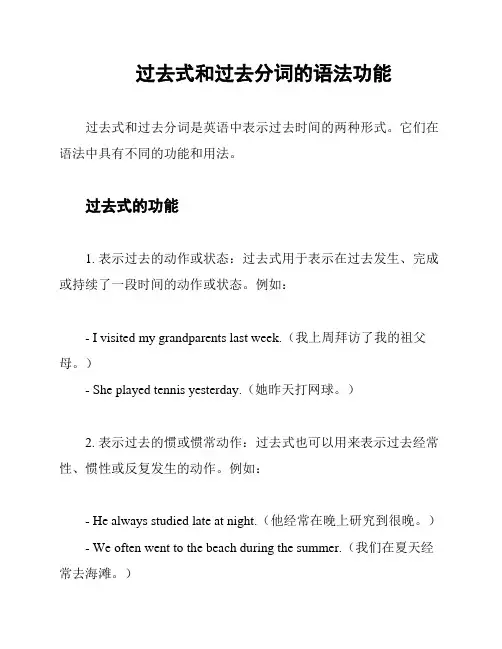
过去式和过去分词的语法功能过去式和过去分词是英语中表示过去时间的两种形式。
它们在语法中具有不同的功能和用法。
过去式的功能1. 表示过去的动作或状态:过去式用于表示在过去发生、完成或持续了一段时间的动作或状态。
例如:- I visited my grandparents last week.(我上周拜访了我的祖父母。
)- She played tennis yesterday.(她昨天打网球。
)2. 表示过去的惯或惯常动作:过去式也可以用来表示过去经常性、惯性或反复发生的动作。
例如:- He always studied late at night.(他经常在晚上研究到很晚。
)- We often went to the beach during the summer.(我们在夏天经常去海滩。
)3. 用于条件句的虚拟语气:过去式在条件句中表示对现在或未来的假设、虚拟情况或不可能发生的事情。
例如:- If I had money, I would buy a new car.(如果我有钱,我会买一辆新车。
)- If she knew the answer, she would tell us.(如果她知道答案,她会告诉我们。
)过去分词的功能1. 作为过去完成时的动词形式:过去分词用于形成过去完成时的谓语动词。
过去完成时表示在过去某个时间或动作之前已经完成的动作。
例如:- I had already eaten dinner when she arrived.(她到达时,我已经吃过晚饭了。
)- They had finished the project before the deadline.(他们在截止日期前完成了这个项目。
)2. 作为被动语态的动词形式:过去分词可以用来形成被动语态的谓语动词。
被动语态表示动作的接受者而不是执行者。
例如:- The letter was written by Tom.(信是汤姆写的。

系统功能语法概述-Halliday系统功能语法概述公元20 世纪,当传统语法威名坠地、逐渐衰落之际,世界的语言学界便迎来了群雄割据的时代……把语言看作功能的流派,看重语言环境重要性的流派,把语言看作复杂结构的流派,崇尚寻求语言极致规律的流派……除此之外许多小流派在这之间登场,也在这之间消逝……当前,语言学界仍存在着众多流派;在此之中,具有比较大影响力的有:1. 强调共时、系统性、语言功能的布拉格学派(Prague School)2. 强调语言环境和语音系统重要性的伦敦学派(London School)3. 注重描写语言研究结构的美国结构主义(American Structuralism)4. 寻求人类极致的语言知识的转换生成语法(Transformative-Generative Grammar)不同的语言学流派的见解不同之处主要集中在句子是怎么组成的,也就是在句法学上面(以后会再说明语言学的不同分支)。
而今天将要涉及的,就是以韩礼德(Halliday) 为首的伦敦学派。
20 世纪初,人类学教授马林诺夫斯基(Malinowski) 认为,一个人所在的语言环境(语境)会对一个人怎么使用和理解语言产生很大的作用。
例如说,有些词语只能在某一群人里面才有特定的意思,或者说在某个特定的场合才有特定的意思。
马林诺夫斯基这种光辉的思想被语言学家弗斯(Firth) 继承了下来。
弗斯把这种光辉思想和现代语言学之父索绪尔(Saussure)的思想结合起来,创立了伦敦学派。
而现在,伦敦学派传承到了韩礼德这一代;因为这个学派注重语言环境和语言系统的重要性,因此伦敦学派也被称为系统语言学(systemic linguistics) 和功能语言学(functional linguistics).韩礼德,人称M.A.K. Halliday, 英格兰约克郡里兹人。
对语言很感兴趣,本科阶段在伦敦大学学习汉语语言文学,之后在北京大学深造,接着在岭南大学(中山大学的前身……)攻读现代汉语。

功能语法导论1. 引言功能语法是一种编程语言的语法特性,用于实现和组织代码。
它可以提供更高级的抽象能力,简化代码的编写和阅读。
本文将介绍功能语法的基本概念和常见用法。
2. 函数定义函数定义是功能语法的核心概念之一。
通过定义函数,我们可以将一段重复使用的代码块封装起来,实现代码的模块化和复用。
在功能语法中,函数通常由以下几个部分组成:•函数名称:用于标识函数的名称,在调用函数时需要使用。
•参数列表:包含函数接受的参数,用于向函数传递数据。
参数可以有默认值。
•函数体:包含函数的实际执行逻辑。
•返回值:函数执行完毕后返回的结果。
下面是一个简单的函数定义的例子:def add(a, b): # 定义函数add,接受两个参数a和b c = a + b # 计算a和b的和return c # 返回计算结果c在上述例子中,我们定义了一个名为add的函数,它接受两个参数a和b,并返回它们的和。
在实际使用中,我们可以通过调用add函数来计算任意两个数的和,如下所示:result = add(2, 3) # 调用add函数,将2和3作为参数传递进去print(result) # 输出计算结果上述代码输出的结果为5,即2和3的和。
3. 匿名函数除了常规的函数定义,功能语法还支持匿名函数(或称为lambda函数)。
匿名函数是一种特殊的函数定义方式,它可以在需要函数功能的地方定义和使用,而无需显式地给函数命名。
匿名函数的定义形式为:lambda参数列表: 表达式下面是一个简单的匿名函数的例子:square =lambda x: x**2# 定义匿名函数square,计算传入参数的平方result = square(5) # 调用square函数,计算5的平方print(result) # 输出计算结果上述代码输出的结果为25,即5的平方。
匿名函数通常用于需要定义简单的逻辑函数或快速创建函数的场景,可以减少代码的书写量和提高代码的可读性。
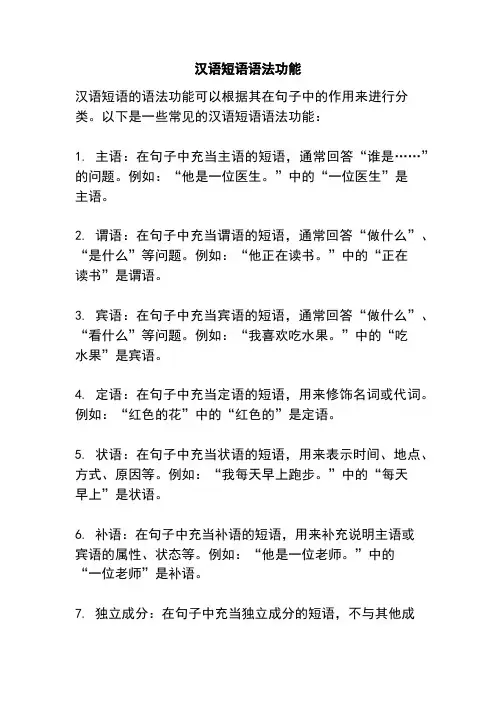
汉语短语语法功能
汉语短语的语法功能可以根据其在句子中的作用来进行分类。
以下是一些常见的汉语短语语法功能:
1. 主语:在句子中充当主语的短语,通常回答“谁是……”的问题。
例如:“他是一位医生。
”中的“一位医生”是
主语。
2. 谓语:在句子中充当谓语的短语,通常回答“做什么”、“是什么”等问题。
例如:“他正在读书。
”中的“正在
读书”是谓语。
3. 宾语:在句子中充当宾语的短语,通常回答“做什么”、“看什么”等问题。
例如:“我喜欢吃水果。
”中的“吃
水果”是宾语。
4. 定语:在句子中充当定语的短语,用来修饰名词或代词。
例如:“红色的花”中的“红色的”是定语。
5. 状语:在句子中充当状语的短语,用来表示时间、地点、方式、原因等。
例如:“我每天早上跑步。
”中的“每天
早上”是状语。
6. 补语:在句子中充当补语的短语,用来补充说明主语或
宾语的属性、状态等。
例如:“他是一位老师。
”中的
“一位老师”是补语。
7. 独立成分:在句子中充当独立成分的短语,不与其他成
分构成句子的主谓关系,通常用来表示感叹、呼唤、祝福等。
例如:“真是太好了!”中的“太好了”是独立成分。
需要注意的是,同一个短语在不同的句子中可能扮演不同
的语法功能,具体的语法功能要根据上下文来确定。
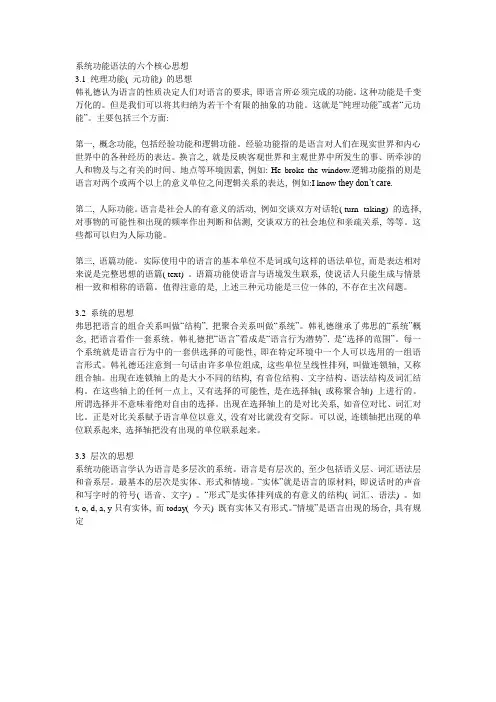
系统功能语法的六个核心思想3.1 纯理功能( 元功能) 的思想韩礼德认为语言的性质决定人们对语言的要求, 即语言所必须完成的功能。
这种功能是千变万化的。
但是我们可以将其归纳为若干个有限的抽象的功能。
这就是“纯理功能”或者“元功能”。
主要包括三个方面:第一, 概念功能, 包括经验功能和逻辑功能。
经验功能指的是语言对人们在现实世界和内心世界中的各种经历的表达。
换言之, 就是反映客观世界和主观世界中所发生的事、所牵涉的人和物及与之有关的时间、地点等环境因素, 例如: He broke the window.逻辑功能指的则是语言对两个或两个以上的意义单位之间逻辑关系的表达, 例如:I know they don’t care.第二, 人际功能。
语言是社会人的有意义的活动, 例如交谈双方对话轮( turn- taking) 的选择, 对事物的可能性和出现的频率作出判断和估测, 交谈双方的社会地位和亲疏关系, 等等。
这些都可以归为人际功能。
第三, 语篇功能。
实际使用中的语言的基本单位不是词或句这样的语法单位, 而是表达相对来说是完整思想的语篇( text) 。
语篇功能使语言与语境发生联系, 使说话人只能生成与情景相一致和相称的语篇。
值得注意的是, 上述三种元功能是三位一体的, 不存在主次问题。
3.2 系统的思想弗思把语言的组合关系叫做“结构”, 把聚合关系叫做“系统”。
韩礼德继承了弗思的“系统”概念, 把语言看作一套系统。
韩礼德把“语言”看成是“语言行为潜势”, 是“选择的范围”。
每一个系统就是语言行为中的一套供选择的可能性, 即在特定环境中一个人可以选用的一组语言形式。
韩礼德还注意到一句话由许多单位组成, 这些单位呈线性排列, 叫做连锁轴, 又称组合轴。
出现在连锁轴上的是大小不同的结构, 有音位结构、文字结构、语法结构及词汇结构。
在这些轴上的任何一点上, 又有选择的可能性, 是在选择轴( 或称聚合轴) 上进行的。
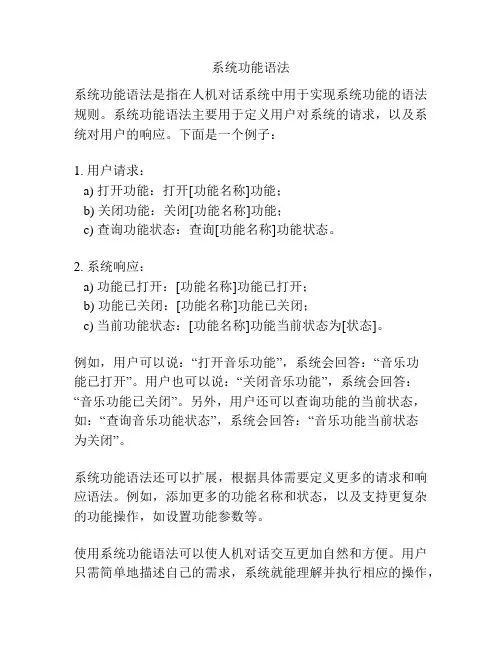
系统功能语法
系统功能语法是指在人机对话系统中用于实现系统功能的语法规则。
系统功能语法主要用于定义用户对系统的请求,以及系统对用户的响应。
下面是一个例子:
1. 用户请求:
a) 打开功能:打开[功能名称]功能;
b) 关闭功能:关闭[功能名称]功能;
c) 查询功能状态:查询[功能名称]功能状态。
2. 系统响应:
a) 功能已打开:[功能名称]功能已打开;
b) 功能已关闭:[功能名称]功能已关闭;
c) 当前功能状态:[功能名称]功能当前状态为[状态]。
例如,用户可以说:“打开音乐功能”,系统会回答:“音乐功
能已打开”。
用户也可以说:“关闭音乐功能”,系统会回答:“音乐功能已关闭”。
另外,用户还可以查询功能的当前状态,如:“查询音乐功能状态”,系统会回答:“音乐功能当前状态
为关闭”。
系统功能语法还可以扩展,根据具体需要定义更多的请求和响应语法。
例如,添加更多的功能名称和状态,以及支持更复杂的功能操作,如设置功能参数等。
使用系统功能语法可以使人机对话交互更加自然和方便。
用户只需简单地描述自己的需求,系统就能理解并执行相应的操作,
提供所需的功能服务。
同时,系统也可以通过语法定义的语句结构来生成合理的语义响应,帮助用户更好地理解系统的操作结果。
语法功能名词解释语法功能名词解释:1. 主语 (Subject):句子中执行动作或者被描述的人或物,通常是句子的核心。
例如:“I love you.”中的“you”就是主语。
2. 谓语 (Predicate):用来说明主语的动作、状态或情况的单词或短语。
例如:“I love you.”中的“love”就是谓语。
3. 宾语 (Object):句子中接受主语动作或影响的人或物。
例如:“I give youa book.”中的“you”就是宾语。
4. 定语 (Adverbial):修饰主语、谓语或宾语的单词或短语。
例如:“The beautiful sunset over the ocean.”中的“beautiful”就是定语。
5. 状语 (Adverbial Clause):修饰动词、形容词、副词或整个句子的单词或短语。
例如:“She sings beautifully.”中的“beautifully”就是状语。
6. 宾语补足语 (Object Pronounced Clause):由代词充当宾语补足语的句子,用来补充说明宾语的状态、动作或情况。
例如:“I give you a book.”中的“you”就是宾语补足语。
7. 谓语补足语 (Predicate Pronounced Clause):由代词充当谓语补足语的句子,用来补充说明谓语的状态、动作或情况。
例如:“I love you.”中的“you”就是谓语补足语。
8. 并列句 (Conjunctions):用来连接并列的句子的单词或短语。
例如:“I like apples and oranges.”中的“and”就是并列句。
9. 分词 (Participles):在句子中作为形容词或副词使用的词汇。
例如:“The book is beautiful.”中的“beautiful”就是分词。
10. 倒装句 (Inversion):将谓语动词提前,主语和谓语调换的句型。
语法功能的名词解释语法是研究语言规则和结构的学科,它帮助我们理解语言使用中的规范和准则。
在语法中,存在许多不同的概念和术语,其中之一就是语法功能。
本文将对语法功能进行深入解释,并探讨其在句子结构中的作用。
一、句子结构概述句子是语言中的基本单位,它由词汇和短语组成。
句子结构是指句子的组成成分之间的排列和关系。
在句子结构中,每个成分都有自己的语法功能,这将在接下来的部分中进行解释。
二、主语主语是一个句子中的核心成分,它通常是动作的执行者或者是句子所描述的人或物。
主语在句子结构中起着重要的作用,它确定了谓语动词的形式和一致性。
例如,在句子“小明喜欢跳舞”中,主语是“小明”。
主语决定了谓语动词的形式为“喜欢”,并且确保谓语动词和主语的人称和数一致。
三、谓语谓语是句子中的另一个核心成分,它描述了主语的动作、状态、属性等。
谓语动词是谓语的主要组成部分,它根据主语的不同来变化时态、语态和人称。
例如,在句子“小明喜欢跳舞”中,谓语是“喜欢跳舞”。
谓语动词“喜欢跳舞”描述了主语“小明”的动作。
四、宾语宾语是句子中的一个成分,它接受动作的影响。
宾语通常是动词的直接对象,它回答了“谁”或“什么”的问题。
例如,在句子“小明喜欢跳舞”中,宾语是“跳舞”。
宾语回答了谓语动词“喜欢”的问题,即“小明喜欢什么”。
五、定语定语是用来修饰名词或代词的成分,它提供了更多的描述性信息。
定语可以是形容词、数量词、名词短语等。
例如,在句子“大象是一个庞大而温顺的动物”中,定语是“庞大而温顺的”。
定语修饰了名词“动物”,给出了关于它的特征和描述。
六、状语状语是句子中用来修饰动词、形容词、副词或整个句子的成分。
状语提供了关于时间、地点、方式、原因等方面的信息。
例如,在句子“他昨天非常努力地学习”中,状语有“昨天”和“非常努力地”。
状语提供了关于动词“学习”的时间和方式的信息。
七、补语补语是用来补充和扩充主语或宾语的成分,它对主语或宾语所述的内容进行解释、补充或限定。
功能语法导论M. A. K. Halliday 的功能语法导论(An Introduction to Founctional Grammar)从语言的功能出发描写和分析语言结构。
全书分为两部分,第一部分为1-5章,其中3-5章是重点,分别从三个角度加以分析:小句组织信息的功能,小句的人际交流功能,小句的示意功能;后一部分为6-10章,主要分析小句以上和小句以下的语言片段,6-7章分析小句群和词组群,后三章讲语调和节律,话语的连贯,和表达的比喻方式。
第二章功能语法Halliday 的“功能语法”有三层意思:(1)旨在说明语言使用的方式。
(2)语言的基本意义成分是功能成分,主要有三种功能,称为“元语言功能”:人与人之间进行交流的功能,表示人类经验过程的功能,根据语境组织信息的功能。
(3)语言的每个成分都能从它在整个语言系统中的功能做出说明。
功能语法以功能而不是以形式为基础,认为语言在本质上是一个意义系统。
Halliday 的“功能语法”是他的“系统理论(systemic theory)”为基础的。
系统理论把语言看作一系列从一般到具体的选择过程,例如,一个音节从开音节和闭音节中选择,如果选闭音节,又可以在结尾辅音是清音和浊音中选择。
Halliday 认为各种形式语法注重组合关系,源头是逻辑学和哲学;各种功能语法注重聚合关系,源头是修辞学和民族学。
功能语法注重话语分析,其基本单位是小句,一个小句可以是一个独立的单句,也可以是复合句中的一部分。
对于语言片段的切分,功能语法采用品级成分分析法(Ranked Constituent Analysis),而不是直接成分分析法。
品级成分分析法首先把语法结构看作由“句子-小句-词组-词-语素”等品级不同的单位构成,然后只是有限地利用成分结构的概念,分析到具有某种功能的单位为止,称作有限切分。
有的语法学家曾把主语按功能分成三类:(1)心理主语-说话人用句子传递的信息所关涉的对象;(2)语法主语-和谓语形式上有一致关系的主语;(3)逻辑主语-动作的实施者。
功能语法入门导读功能语法入门导读:一、基本概念1. 表达式表达式在功能语法中是一个类似于数学公式的概念,例如“10 + 5”或“8 - 4”。
表达式主要用于计算结果,对程序的实际运行没有实质性影响。
当在交互模式下输入一个表达式时,解释器会自动输出该表达式的计算结果。
2. 语句语句在程序中执行特定的功能,如打印信息、获取数据或为变量赋值。
例如,“print()”或“input()”以及“a = 10”都是语句的示例。
执行语句通常会对程序产生一定的影响,但在交互模式下,执行结果可能不会立即显示。
3. 程序程序是由一系列语句和表达式构成的。
它是一组指令的集合,用于实现特定的功能。
4. 函数函数是执行特定功能的语句集合。
它以特定的格式呈现,例如“xxx()”,例如“min()”。
函数可以分为两类:内置函数和自定义函数。
内置函数是由解释器提供的,可以直接在程序中使用;而自定义函数则是由程序员自己创建的。
二、功能语法入门方法对于初次接触功能语法的读者,建议从以下几个方面入手:1. 熟悉基本概念:首先要了解并熟悉上述提到的表达式、语句、程序和函数的基本概念。
这些概念是功能语法的基础,理解它们对于后续的学习至关重要。
2. 学习语法规则:深入学习功能语法的规则和结构,理解各种语句和表达式的正确格式和用法。
通过大量的练习和实践,逐渐提高自己的编程技能和语法理解能力。
3. 实践应用:将所学的语法知识应用到实际的编程项目中。
通过编写程序、调试代码和解决实际问题的过程,加深对功能语法的理解和掌握。
4. 参与社区交流:加入相关的编程社区或论坛,与其他程序员交流和学习。
通过分享经验、解答问题以及参与讨论,不断提高自己的编程水平和对功能语法的理解。
5. 持续学习与更新:编程技术和功能语法不断发展,需要保持持续学习的态度。
关注最新的技术动态和最佳实践,不断更新自己的知识和技能。
总之,功能语法入门需要一定的时间和实践,需要坚持不懈地学习和探索。
Ⅰ. Introduction From Firth’s theories in the London School, Michael Alexander Kirkwood Halliday developed his own theories of language, which is systemic functional grammar. His systemic functional grammar is a sociologically oriented functional linguistic approach and it is also one of the most influential linguistic theories in the 20th century. His grammar has exerted a great influence on various disciplines related to language, such as sociolinguistics, stylistics, machine translation, especially on language teaching and discourse analysis. This paper explores the application of systemic functional grammar in analysis of the discourse. This paper adopts the textual metafuction in analysis of context, structure of theme, and transivity in the discourse. The paper falls into four parts. The first part is the general introduction of the content in the paper. In the second part, the brief introduction of systemic functional grammar is presented. In the third part, the application of systemic functional grammar in analysis of the discourse from context, theme, and transivity aspects are discussed. The last part is the conclusion. Ⅱ. Introduction of systemic functional grammar In fact, systemic functional grammar is based on two facts: the first is, language users are actually making choices in a system and trying to realize different semantic functions in social interaction; the second is language is inseparable from social activities of man. Thus, it takes actual uses of language as the object of study. According to Halliday’s theories, there are three metafunctions which are ideational metafunction , interpersonal metafunction and textual metafunction. The ideational metafunction means people use language to describe their experience about the outside word and they also use language to describe what happened around them. The interpersonal metafunction means people use language to interact with each other, to establish and to maintain their relations. They also use language to influence other people’s actions or to express their point of view about the world. The last one is the textual matafunction which means the ways that people organize information. It presents the relation between information and the context when people read or write (Thompson, 2008). In fact, these three metafunctions are interrelated. They are closely connected during people’s interaction, discourse coherence, and mutual communication. Systemic functional grammar holds the view that language is the product of the society. As a method of people’s communication, it has various functions. It is a kind of textual grammar, and it can be used to analyze the discourse. Thus, the author holds the view that it is important to apply the discourse analysis which is guided by the systemic functional grammar into extensive reading. Ⅲ. The application of systemic functional grammar to discourse analysis Discourse is a language unit which consists of a series of clauses. Discourse analysis is a method that is to understand the text from the whole point of view. The paper adopts the systematic functional grammar to analyze the “The Expensive Fantasy of Lord Williams” from the context, theme, and transitivity aspects. 3.1 context The formation of any discourse can not be separated from the context, which includes the circumstances, society, culture, and surrounding people or things. Thus, if we want to have a deep understanding of the discourse, the context should come into consideration first. “context is the environment and basis for generating discourse, and there is no discourse which can get rid of the context”(Halliday, 2004). Halliday concluded three factors that determine the situational elements of language features which are: field, tenor and mode. He thought that these three elements are in accordance with the three metafunctions which are ideational metafunction, interpersonal metafunction, and textual metafunction. In the text “The Expensive Fantasy of Lord Williams”, the field is: an office worker named Anthony Williams who in order to maintain his imagination of Scotch nobility constantly stole money from London police office, at last, he was sent into the prison. The tenor of the text is Willianms who imagined himself as nobility and the common villagers, their social status are quietly different. The mood of the text is the formal written English. According to the analysis of the three elements of the